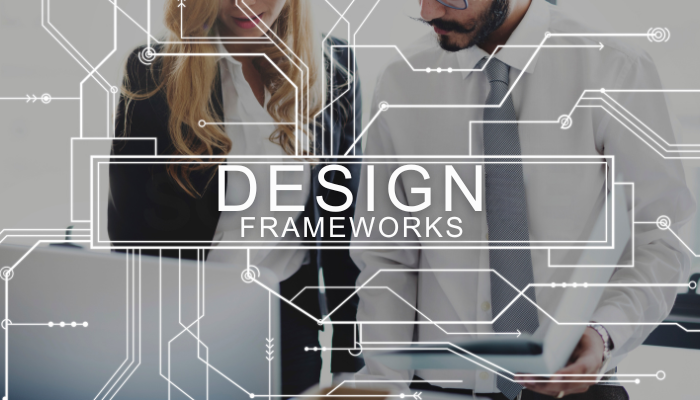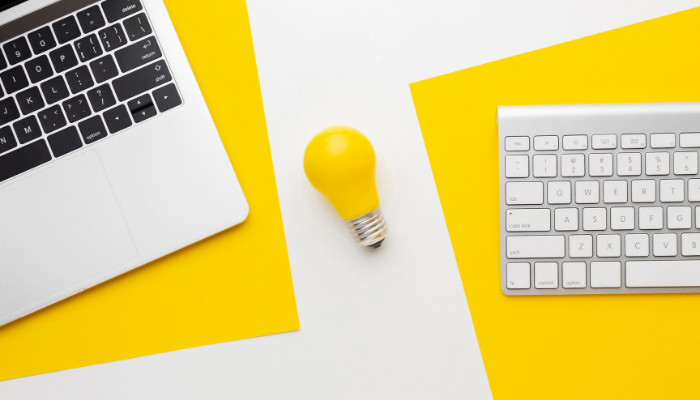Ever wondered why some brands always look so cool and put together? It’s because they have a design framework – a set of rules and guidelines that helps them keep everything looking consistent.
Okay, think about your favorite brand. How are their logos, websites, and packaging? Notice how they all match? That’s the power of a Design Framework.
A study showed that companies with strong design frameworks actually make twice as much money as those without one!
So, what’s the big deal about frameworks? They help teams work together smoothly and create better designs. They’re like a roadmap, guiding everyone in the same direction.
Want to learn more about design frameworks and how they can help you create amazing apps or products? Keep reading!
Introduction to Using Design Frameworks
Design frameworks are organized systems that guide your design process, providing rules and tools to keep everything consistent. They help you stay on track by offering reusable elements, making sure your designs look and feel the same across every project. With frameworks, you can reduce the complexity of designing and improve the overall flow.
Why Use Design Frameworks?
1. Manage complex design projects
Design projects can get overwhelming, right? Frameworks break things down into smaller, manageable steps, so you don’t have to tackle everything at once. It makes the whole process smoother and easier to keep track of.
2. Ensure consistency across designs
Ever noticed how some brands look the same across everything they do? That’s the power of consistency. Design frameworks help you create designs that look and feel uniform across different platforms, whether it’s a website, app, or marketing material.
3. Enhance team collaboration and productivity
When everyone on your team follows the same framework, there’s less confusion. Everyone knows what to do and how to do it, making collaboration much easier. This leads to faster results and fewer headaches.
4. Scale your designs easily
As your projects grow, design frameworks make it easier to expand without losing quality. Whether you’re adding new features or adapting to trends, the framework ensures everything stays aligned and consistent.
5. Boost the user experience
Users love familiarity. When your design is consistent, it’s easier for users to navigate and understand what to expect. This makes their experience smoother and more enjoyable, keeping them coming back.
Ever wish your design could be like a favorite pair of shoes—comfortable and reliable? At Codewave, we specialize in enhancing customer journeys to make your designs just that! Our customer journey design service helps you create intuitive experiences that keep users engaged and satisfied.
6. Save time and effort
Why reinvent the wheel every time? Frameworks let you reuse design elements, which saves you tons of time and effort. You get to focus on what really matters—creating great designs—without starting from scratch.
7. Guides in Problem-Solving
Design frameworks provide a roadmap for tackling design challenges. By breaking down the problem into smaller, manageable steps, they help you stay focused on finding effective solutions without getting overwhelmed.
8. Flexibility to Adapt
No two projects are the same, but a strong framework allows for flexibility. Whether you’re designing a website, app, or product interface, frameworks can be tailored to meet specific design requirements while keeping the process structured.
9. Streamlined Feedback and Revisions
With a framework guiding the design, it’s easier to gather feedback and make revisions. Teams know where to make adjustments without disrupting the entire project. This makes the revision process smoother and quicker.
Now that you know why design frameworks are awesome, let’s talk about some popular options.
Discovering the Best Design Frameworks for Your Projects
Design frameworks are your design blueprints, providing a solid foundation to build stunning interfaces. From responsive layouts to component libraries, these frameworks offer a wealth of tools to streamline your design process.
So, let’s explore some of the most popular ones and see how they can elevate your design game!
1. Double Diamond Framework
The Double Diamond Framework is a widely used method in design that helps teams navigate through challenges step by step. It’s broken down into four easy phases that guide you from exploring the problem to delivering the final solution.
- Discover: This is where you gather information, research, and try to understand the problem better. You’re basically opening your mind to all possibilities at this point.
- Define: After collecting all that data, it’s time to narrow things down. You figure out the core problem you’re going to solve based on your research.
- Develop: Here, you start coming up with ideas, creating prototypes, and testing them. It’s all about trying different solutions to see what works best.
- Deliver: Finally, this is the phase where you finalize your solution and bring it to life. Once it’s out there, you collect feedback to improve further.
Why the Double Diamond Framework Works
- Simple and Clear: The “diverge” and “converge” structure makes it easy to follow and keeps everyone on the same page.
- Flexible: Whether you’re solving a small issue or a big design challenge, this framework adapts to your needs.
- Focuses on Users: It ensures that you’re solving problems that actually matter to users by grounding everything in research.
2. Design Thinking Process
The Design Thinking Process is one of the best design frameworks to help you solve problems creatively. It’s made up of five clear stages, each one guiding you to focus on the user’s needs while encouraging constant improvement. This method keeps your team aligned and focused on delivering practical, innovative solutions.
- Empathize: Start by understanding what your users really need. This stage is about getting to know their pain points and challenges by talking to them and doing research.
- Define: Once you’ve gathered insights, it’s time to clearly define the problem. Here, you make sure you’re solving the right issue, so your efforts stay focused.
- Ideate: Now comes the fun part—brainstorming! In this stage, you and your team think of as many ideas as possible, allowing creativity to flow without any limitations.
- Prototype: After you narrow down the ideas, it’s time to create a simple model or version of your solution. Prototypes let you test ideas quickly and see how they work in the real world.
- Test: Finally, you test your prototype with users. Gather feedback, see what works, and make changes as needed. You might repeat this step several times until the solution feels right.
Why Choose the Design Thinking Process?
- Focuses on Users: You put the user’s needs at the center of every step, making sure your solutions are truly helpful.
- Encourages Team Collaboration: This process works best when you collaborate with others, bringing in different viewpoints for more creative solutions.
- Allows for Ongoing Improvement: Design Thinking isn’t a one-and-done process. It lets you make adjustments based on feedback, so your solution evolves over time.
Looking to add some magic to your projects? At Codewave, we bring Design Thinking to life, making creativity part of everyone’s job! Check out our portfolio to see how we turn innovative ideas into reality. Let’s transform your vision together!
3. Hook Model
The Hook Model is a design framework that helps you build products people love to keep using. It follows four steps that guide users through a process, helping them form habits with your product.
- Trigger: This is what prompts users to start using your product. It can be something external, like a notification, or something internal, like feeling bored. Understanding these triggers lets you design experiences that catch users at the right time.
- Action: After the trigger, the user takes a small action, like clicking or scrolling. You want this step to be quick and easy so they can engage without hesitation.
- Variable Reward: Here, users receive something different each time, like new content or an unexpected bonus. This keeps things interesting and encourages them to come back for more.
- Investment: In this final stage, users put in effort, whether it’s by saving preferences, uploading content, or spending time on your app. This investment makes them more likely to return, deepening their connection to your product.
Why Use the Hook Model?
- Boosts Engagement: It’s ideal for creating products that people use regularly, especially apps and platforms.
- Taps into User Behavior: The unpredictable rewards keep users curious and excited, which leads to stronger engagement.
- Increases Retention: As users invest time and effort, they become more committed to your product and keep coming back.
4. Agile UX
Agile UX combines design and development, ensuring both teams work together in every sprint. This framework follows a continuous process of designing, gathering user feedback, and adapting based on real-time data. Here’s a quick breakdown of the process:
- Collaboration: Designers and developers work side by side, integrating changes as they come, ensuring faster iterations.
- User Testing: Each sprint includes regular user feedback, allowing you to make informed design tweaks without waiting until the end.
- Flexibility: Designs evolve with changing project needs, ensuring agility without losing focus on user experience.
Why Choose Agile UX?
- Fast Adaptation: Agile UX allows you to quickly pivot design strategies based on immediate feedback, ideal for dynamic projects.
- User-Focused Approach: Constant testing ensures the design always aligns with user needs and expectations.
- Continuous Improvement: By iterating in short sprints, your designs improve steadily, avoiding bottlenecks in the development process.
5. Atomic Design
Atomic Design is a straightforward way to build a consistent design system by breaking everything down into smaller, reusable parts. You start with the tiniest elements and work your way up to complete pages. Here’s how it works:
- Atoms: The smallest elements like buttons, input fields, and labels.
- Molecules: Simple groupings of atoms, such as a search bar (input field + button).
- Organisms: More complex groups that form distinct sections of a webpage, like navigation bars.
- Templates: Layouts that arrange organisms into a page structure.
- Pages: Fully functioning interfaces where all components come together.
Why Choose Atomic Design?
- Consistency Across Products: By reusing components, you ensure design elements remain uniform across all parts of the product, reducing errors and inconsistencies.
- Scalability: This method makes it easy to scale your design as your product grows, without needing to start from scratch each time.
- Efficiency in Design and Development: Design and development teams can work faster by using predefined components, leading to quicker turnarounds.
6. User-Centered Design
User-Centered Design (UCD) is a design framework that focuses on putting users at the core of the design process. It ensures that every decision made is based on real users’ needs, preferences, and limitations. Here’s how the UCD process typically works:
- Research: Start by understanding your users through interviews, surveys, and observations.
- Design: Create design concepts based on the insights you’ve gathered.
- Prototype: Build simple models to visualize and test your ideas.
- Testing: Gather feedback from real users to see what works and what doesn’t.
- Iteration: Refine and improve your design based on the feedback.
Why Choose User-Centered Design?
- Improves User Satisfaction: Designs focused on user needs lead to a smoother, more enjoyable experience, making your product easier to use.
- Saves Time and Resources: Testing early on helps catch issues before they become costly problems down the line.
- Increases User Engagement: Products designed with users in mind tend to be more engaging, encouraging them to stay and use your product longer.
Now, let’s talk about how to choose the right framework for your design projects!
How to Choose the Right Framework for Your Design
Picking the right design framework can feel a bit tricky, but don’t worry! With the right approach, you can find a choice that really works for you. Here are some easy tips to help you make the right decision:
Know Your Goals
What do you want to achieve with your design? Whether it’s making it easier for users to navigate or creating a more engaging experience, understanding your goals can help you focus. For instance, if you want to improve usability, consider a framework like User-Centered Design.
Understand Your Audience
Who are you designing for? Spend some time learning about your users’ needs and preferences. Knowing what they like can help you pick a framework that fits. If your users need regular updates, Agile UX might be perfect for you.
Look for Flexibility
Choose a framework in design that allows you to adapt and change as needed. Atomic Design is a great example, as it breaks down components into smaller pieces, making it easier to modify and combine them. This way, you can keep your design consistent even as it evolves.
Encourage Team Collaboration
If your team has different skill sets, find a framework that supports teamwork. Frameworks like Design Thinking promote brainstorming and sharing ideas, helping everyone contribute to the creative process.
Do Your Research
Take some time to learn about popular design frameworks, such as Agile UX and User-Centered Design. Each has its unique benefits, so think about which one aligns best with what you want to accomplish. It’s about finding a good fit for your project.
Test and Iterate
Don’t hesitate to try things out! Start with a framework, put it into practice, and gather feedback. If it’s not hitting the mark, be open to switching to something else. This approach can lead you to the right solution that boosts your design consistency.
Stay Updated
The design world is always changing. Keep an eye out for new trends and design frameworks that could offer fresh ideas and techniques. For example, design systems have become popular for ensuring brand consistency across different platforms.
Ask for Feedback
Share your designs with users and team members early on. Their input can show you if your chosen framework is working well or if adjustments are needed.
Next, we’ll guide you through implementing a design framework that fits your needs perfectly!
Implementing a Design Framework: Your Friendly Guide
Getting a design framework up and running can feel like a big task, but it doesn’t have to be! Here’s a straightforward guide to help you through the process. Let’s dive in!
Start with Your Goals
First things first, what do you want to achieve? Are you trying to make your users happier, keep your brand looking sharp, or make your design process smoother? Knowing what you want will help you pick the right framework.
Pick the Right Framework
Take a look at different design frameworks out there. Consider popular ones like User-Centered Design (UCD) or Agile UX. Each one has its strengths, so choose the one that fits your needs best.
Get Your Team Involved
Don’t keep this all to yourself! Bring your team into the conversation early. Discussing your framework choice will help everyone understand what’s happening and work better together. It’s all about teamwork!
Make a Plan
Once you’ve chosen a framework, outline the steps for putting it into action. Break things down into small tasks and set deadlines. Having a plan will keep you and your team on track.
Create a Design System
If you’re using design frameworks like Atomic Design, build a design system. This is like your toolbox, filled with reusable parts that keep your designs consistent. It’ll save you time and effort down the road!
Want to create a design system that sings? (Think happy users, not off-key karaoke.) Head over to Codewave‘s UI/UX design services. We’ll help you craft a system that’s as smooth as butter (and way more visually appealing).
Ask for Feedback Often
Don’t wait until the end to hear what others think. Regularly ask your team and users for their opinions as you go along. Getting feedback early helps you spot problems and make changes as needed.
Test and Tweak
After you’ve implemented your framework in design, take some time to test your designs. Are they hitting the mark? Gather feedback and be ready to make tweaks. Remember, design is all about improving!
Want an expert to help you test and polish your design to perfection? Head over to Codewave‘s automation testing services. We’ll help you identify any bugs and ensure your design is as smooth as butter (and way more user-friendly).
Keep Good Records
Document everything! Write down your decisions, processes, and any changes you make. This will help keep everyone on the same page and serve as a reference for future projects.
Celebrate Your Wins
Once everything is up and running, take a moment to celebrate! Acknowledge your successes with your team. It’s a great way to boost morale and keep everyone motivated for future projects.
By following these steps, you’ll successfully implement your design framework and create a more consistent, user-friendly experience.
Now, let’s wrap things up and reflect on the key points we’ve covered together!
Conclusion
Design frameworks are like a roadmap for your creative process. They help you stay organized and focused, so you can create amazing designs that are both consistent and innovative.
A recent study by Adobe found that companies that use design frameworks see a big boost in their business. They have 1.5 times more customers and their customers are 2.5 times happier!
Frameworks give you a structure to follow, so you can spend more time being creative and less time worrying about the details. They help you create designs that are consistent across all your projects, so your customers have a positive experience every time.
As the famous designer Paul Rand once said, “Design is the silent ambassador of your brand.” So, let design frameworks be your guiding light to create memorable and effective experiences.
At Codewave, we specialize in design-thinking-led digital innovation. We’re here to help you choose and implement the right frameworks that enhance your design projects. Reach out to Codewave today, and let’s transform your ideas into impactful designs! Also read: Developing Your Product Strategy Framework: Essential Steps
Codewave is a UX first design thinking & digital transformation services company, designing & engineering innovative mobile apps, cloud, & edge solutions.







